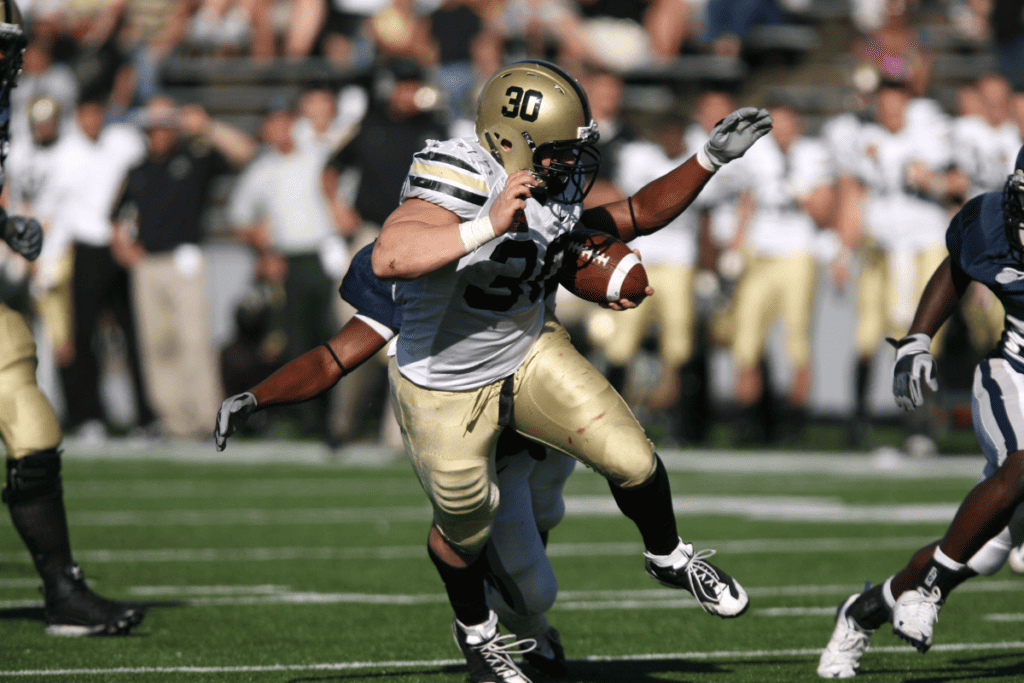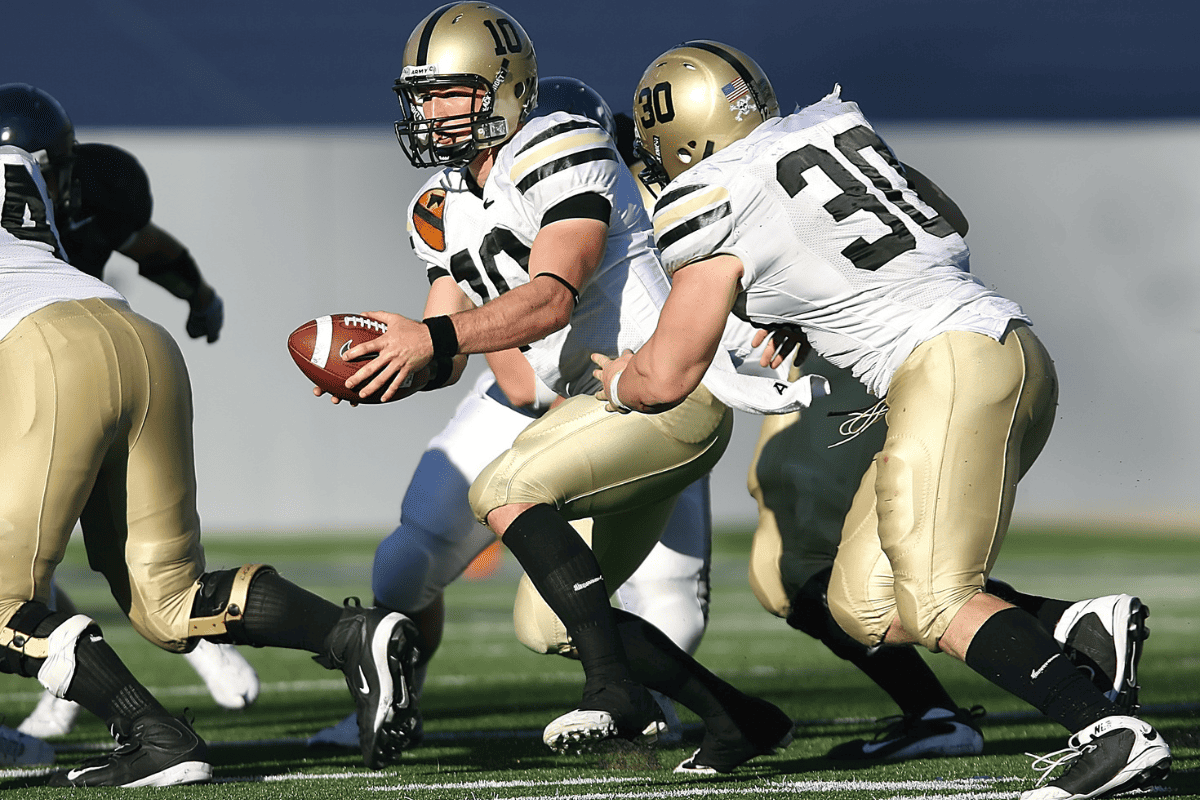Fullback vs Running Back: What’s the Difference?
In American football, every position on the field has a unique role that contributes to the team’s success, especially in the offensive lineup. Among these positions, the fullback and running back are pivotal, yet they often get confused by those new to the sport.
Both positions are integral to a team’s ground game, but they have distinct responsibilities and skill sets. The fullback, often seen as the unsung hero, primarily blocks for the running back and quarterback, while the running back is known for rushing with the ball and making significant yardage gains.
This article aims to clarify the differences and similarities between these two roles, helping newcomers understand the strategic importance of the fullback and running back in football’s offensive play.
Running Back: Agility and Speed in the Spotlight

The running back is a key figure in a football team’s offense, known for their agility and speed. Positioned behind or beside the quarterback, the primary responsibility of a running back is to carry the ball on rushing plays.
Their goal is to navigate through the defense, using their speed and agility to avoid tackles and gain as much yardage as possible. Running backs also play a vital role in the passing game; they can receive short passes and contribute to the team’s aerial attack.
Additionally, running backs are occasionally required to block, protecting the quarterback from oncoming defenders. The effectiveness of a running back hinges on their ability to quickly identify the best paths through the defense and their capability to evade or withstand tackles, making them a dynamic and crucial part of any offensive strategy.
Key Qualities of a Top-Notch Running Back
To excel in their role, a running back must possess a combination of physical and mental attributes. Speed is paramount, allowing them to outrun defenders and make quick breaks. Agility is equally important, as it enables them to make sharp cuts and changes in direction to avoid tackles.
Vision is crucial for a running back; they need to quickly assess the field, identify gaps in the defense, and make split-second decisions. Endurance and physical toughness are also vital, as running backs often endure multiple hits throughout the game.
Additionally, good hands are important for catching passes, and an understanding of blocking schemes can enhance their versatility on the field.
Read More:
Fullback: The Unsung Hero of the Offense

The fullback, while not as prominently featured as the running back, plays a critical role in a football team’s offense. Traditionally positioned in front of the running back, the fullback’s primary duty is to act as a lead blocker, clearing paths and protecting the running back during rushing plays.
Fullbacks also provide crucial blocks to safeguard the quarterback, especially during passing plays. While not their main role, fullbacks may occasionally carry the ball on short-yardage or goal-line situations. They can also be used as receivers, typically for short passing plays.
The fullback’s role requires a unique blend of strength and versatility, as they contribute both in protecting their teammates and in executing offensive plays.
Essential Skills for an Effective Fullback
An effective fullback needs to possess a specific skill set that complements their role in the offense. Foremost among these is blocking ability; they need to be strong and skilled enough to effectively open running lanes and protect the quarterback.
Physical strength and toughness are vital, as fullbacks frequently engage in physical battles with defenders. Versatility is also important; an ability to carry the ball and catch passes can make the fullback a more dynamic threat.
Additionally, tactical awareness is key, as fullbacks must understand defensive formations and adjust their blocking strategies accordingly. Good hand-eye coordination can be beneficial, particularly for fullbacks who play a role in the passing game.
Comparing Roles: Fullback vs Running Back
Though both fullbacks and running backs operate in the backfield, their roles in a football team’s offense are quite distinct. The running back is primarily a ball carrier, using speed and agility to make significant gains through rushing plays. They are often key players in the team’s ground attack and can also contribute to the passing game.
In contrast, the fullback’s role is more focused on physical play and protection. They serve as lead blockers for the running back and provide critical protection for the quarterback.
While the running back is often the star of the ground game, the fullback’s contributions, though less glamorous, are vital to the success of the offense, particularly in creating opportunities for the running back to excel.
Common Ground: Shared Skills in the Backfield
Despite their different primary roles, fullbacks and running backs share several fundamental skills and attributes. Both positions require a deep understanding of the team’s offensive strategies and an ability to read and react to the defense’s formations and movements.
Physical fitness and resilience are crucial, as both fullbacks and running backs often face intense physical contact during the game. Mental toughness and the ability to perform under pressure are also shared traits, as both positions play key roles in high-stakes situations, such as third-down conversions or goal-line stands.
Additionally, both fullbacks and running backs must have effective communication skills to coordinate with each other and the rest of the offense, ensuring that plays are executed smoothly.
How Fullbacks and Running Backs Work Together
On the field, fullbacks and running backs work in tandem to enhance the team’s offensive effectiveness. The fullback’s blocking is crucial in creating openings for the running back to exploit. By effectively clearing paths, fullbacks enable running backs to maximize their rushing potential.
In passing situations, fullbacks often take on key blocking responsibilities, providing the quarterback with more time and protection to execute passes, which can include check-downs to the running back. This interplay between the fullback and running back not only exemplifies teamwork but also adds a layer of complexity to the offense, making it more difficult for defenses to predict and counter the team’s strategies.
Celebrated Backs in Football History
The history of football is rich with exceptional players who have defined and redefined the roles of fullback and running back. Celebrated running backs like Jim Brown, Emmitt Smith, and Barry Sanders are remembered for their extraordinary rushing abilities and game-changing plays.
Fullbacks, although often overshadowed, have had their share of legends, including players like Jim Taylor, Mike Alstott, and Lorenzo Neal, known for their exceptional blocking skills and contributions to their team’s offensive success. These players have set high standards in their respective positions, leaving a legacy that continues to influence and inspire current and future generations of football players.
Conclusion
For those new to football, understanding the roles and dynamics of the fullback and running back positions is essential to appreciate the nuances of the game. While the running back often garners more attention for their rushing abilities, the fullback’s role as a blocker and versatile player is equally crucial to the team’s offense.
Together, these positions form a critical part of a team’s strategy, each complementing the other to create a balanced and effective offensive attack. Recognizing the unique yet interdependent roles of fullbacks and running backs offers a deeper insight into the strategic complexity and teamwork that define the sport of football.

